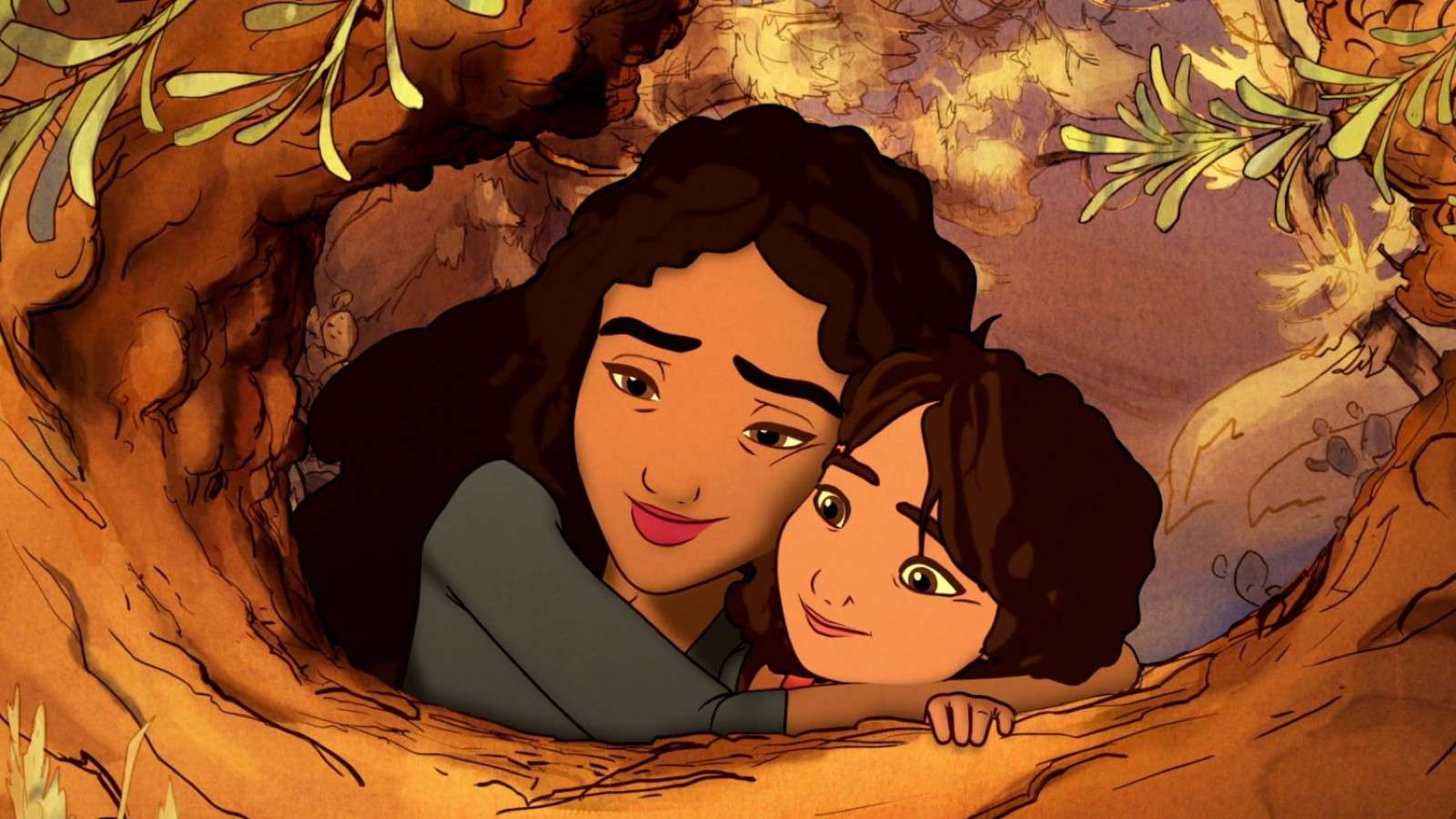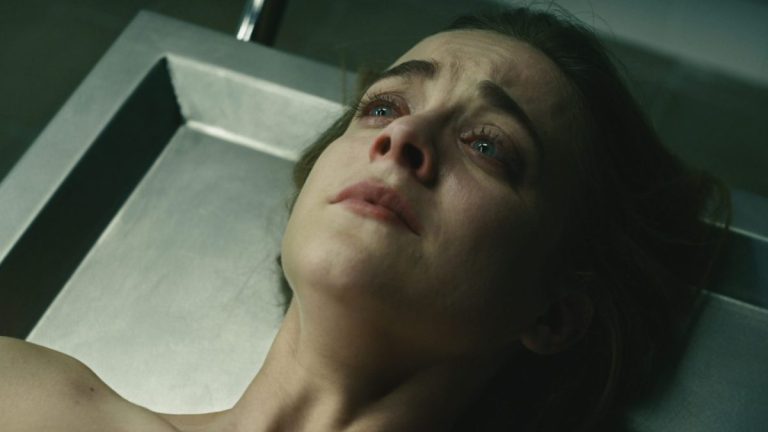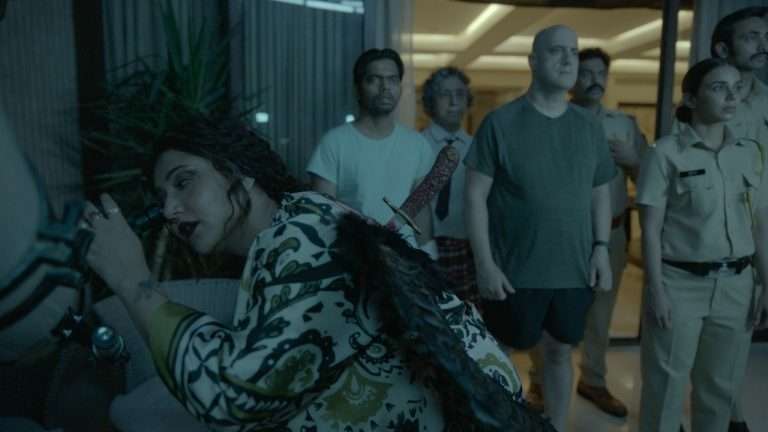In 2014, Salma Hayek produced the animated film Kahlil Gibran’s The Prophet, an adaptation of the best-selling poetry book The Prophet, written by the Lebanese-American Poet Gibran Kahlil Gibran (1883-1931) in 1923. Hayek presented the UK premiere of the film on International Women’s Day as part of the Women of the World event at London’s Southbank Centre in 2015. In an interview with The Guardian, she emphasized the significance of the film to female viewers because it is “about the courage to speak up, to believe you are worth being listened to.”
In the movie, Kamila (Hayek) is a widowed mother working as a housekeeper for Al-Mustafa (Liam Neeson), a foreign poet and political activist who is under house arrest in Lebanon under the Ottoman Empire. After long years of house arrest, an Ottoman sergeant arrives to tell Al-Mustafa that the authorities have set him free. The sergeant and a soldier named Halim escort Al-Mustafa to the ship that would bear him back to his homeland. On his way to the ship, Al-Mustafa stops to preach moralistic sermons to the townsfolk.
The opening scene sets the terms with an establishing shot of Almitra (Quvenzhane Wallis), Kamila’s voiceless daughter, performing her daily routine of causing trouble in the local market, stealing, and jumping from one building to another with her seagull friend. As Kamila searches for her daughter in the market, she hears the merchants chide Almitra as a thief and a troublemaker. The mother promises the storekeepers to pay for all the damages and losses once she receives her salary.
The acts of stealing, flying over roofs, and causing trouble in the market speak to the child’s traumatic struggles to cope with her father’s death. Two more scenes illustrating Almitra’s traumatic struggles show her visiting her father’s tomb and gazing at his portrait. The opening scene is hierarchically the most significant since it sets the terms for the struggles of a poor widow and her voiceless daughter.
During the 2014 Cannes Film Festival, Hayek chose not to identify as a Mexican-American actress but as a Lebanese woman [1]. As a feminist, she drew much of her inspiration for the film from Gibran’s position on equality between people of all genders. More specifically, Gibran’s sermon on marriage, depicting the man and woman as equal pillars supporting a temple, resonated with her [2]. The film features a scene where a couple is dancing in a temple while Neeson’s voice can be heard in the background reading the entire sermon.
Kamila develops a Lebanese-Mexican identity in the film. For one thing, Hayek names Kamila after Gibran’s mother, Kamileh Rahmeh, whom she views as a source of inspiration [3]. For another, Kamila takes on the facial features of Mexican painter Frida Kahlo. The character of a Latin-Lebanese widow echoes Kamileh’s stay in Brazil with her first husband, ‘Abd al-Salam Rahmeh, who died shortly after the birth of their first child, Buṭrus, a situation that forced her to move back to Lebanon [4]. Little wonder, then, that the film proved to be a personal triumph for Hayek “on the level of her equally dedicated efforts to bring ‘Frida’ to the screen” [5]. The resemblance between Kamila and Frida reveals Hayek’s intended double entendre and establishes a solid feminist dimension of the film’s narrative.

With Frida’s face and Hayek’s voice, the film is reminiscent of her Frida performance. This representation becomes even more salient when we consider the fact that Alfred Molina (Diego Rivera in Frida) provides the voice for the character of the Ottoman sergeant, who happens to be Kamila’s employer. In one crucial scene, he is shown speaking harshly to Kamila when she offers to help Al-Mustafa pack up his belongings, reminding her that cleaning is her job.
He insults her daughter as a silent thief and threatens to throw them in jail. These images tie in with the observation that a patriarchal social order prevailed in Ottoman-era Lebanon [6]. The film demonstrates the prevalence of patriarchal gender norms and internalized gender roles, as seen in male domination in the marketplace and the relegation of women to the domestic sphere. A telling scene involves the waiter Yūsuf summoning the female cook Bashīra to prepare a meal for Al-Mustafa. This emphasis on women holding domestic roles reflects the current state of affairs in Lebanon, where nearly all migrant domestic workers are women [7].
Against this patriarchal backdrop, the animated film glorifies Kamila as a courageous, independent woman while at the same time depicting the misery that she endured in her work as a housekeeper. It is important to note that Kamileh and Frida fled an abusive marriage and eventually settled in the United States, where the former worked as a housekeeper and sold textiles to support her four children. Gibran’s father, Khalil, indulged in excessive drinking and showed little interest in fulfilling his family’s obligations.
The film brings to mind Frida’s struggles as a feminist figure who fought against a gender-biased society. Just as Frida emerged as a universal feminist figure, Kamila is constructed as a role model, a strong Lebanese woman who singlehandedly stood up for her family. Hayek explained her choice of this particular character: “Because of her courage, Kahlil Gibran was inspired to be the man that he became” [8]. In the film, Kamila symbolizes women’s commitment to work as a means of independence, having befallen on hard times following the death of her husband. The filmmakers challenge the patriarchal ideal of women’s embeddedness in marriage and family by portraying Kamila as a strong widow determined to fight for a decent life for her voiceless daughter.
When a battle between the townspeople and the Ottomans begins in front of the prison to free Al-Mustafa, women are seen fighting alongside their male counterparts. Such allusions to women’s participation in national liberation movements are historically accurate because they reflect the fact that women in Greater Syria between 1908 and 1918 “both participated in national struggles and strives to protect their rights as women in their own societies” [9] Notable Lebanese feminist activists, such as Ibtihaj Kedoura and ‘Anbara Salam al-Khalidi, were among the Muslim women who organized a club in Beirut in 1917 in order to promote nationalist and feminist causes [10]. Importantly, the scene of fighting defies the patriarchal social order by moving women from the domestic sphere to the public domain of politics.
Such feminist representations and the characters of Kamila and Almitra were central to Hayek’s advocacy for women’s rights in Lebanon since the film’s release. Within the context of expressing her admiration for Gibran’s mother, she criticized the Lebanese government for enacting patriarchal laws that prevent women from passing on their nationality to their children, saying that “our blood is as good as a man’s blood, and we carry them in our wombs, so (the blood) is, even more, ours than anyone else. We should be able to pass on our heritage to our children” [11]. With the multifaceted characters of Kamila and Almitra, the film engages with the past and present of Lebanon and, in so doing, depicts a patriarchal Lebanon under Ottoman rule.
Read More:
White Gaze in Sita Sings the Blues (2008)
Cinematic Chronicles of Socioeconomic Struggles: A Trifecta of 20th Century Classics
On Female Violence in Thelma and Louise
The Prophet (2014) Movie Links: IMDb, Rotten Tomatoes, Wikipedia, Letterboxd
References:
1. BBC News, May 18, 2014, https://www.bbc.com/arabic/artandculture/2014/05/140517_cannes_gibran_hayek.
2. Olivia Salazar-Winspear, “The Prophet’: Salma Hayek Brings Khalil Gibran’s Lessons in Life to the Big Screen,” France 24, December 7, 2015,
https://www.france24.com/en/20151203-encore-cinema-salma-hayek-prophet-khalil-gibran-philosophy.
3. Sylvia Westall, “Salma Hayek Pays Tribute to Lebanese Roots with Film of ‘The Prophet,’” Reuters, April 27, 2015, https://www.reuters.com/article/lebanon-film-hayek-idINKBN0NI16Y20150427.
4. Suheil Bushrui and Joe Jenkins, Kahlil Gibran, Man and Poet: A New Biography (London: Oneworld, 1998), 25.
5. Peter Sobczynski, “Kahlil Gibran’s The Prophet Movie Review” Roger Ebert, August 7, 2015, https://www.rogerebert.com/reviews/kahlil-gibrans-the-prophet-2015.
6. Fruma Zachs and Yuval Ben-Bassat, “Women’s Visibility in Petitions from Greater Syria During the Late Ottoman Period,” International Journal of Middle East Studies 47, no. 4 (2015): 766.
7. Zeina Mehzer, Gabriella Nassif, and Claire Wilson, “Migrant Workers’ Rights and Women’s Rights – Women Migrant Domestic Workers in Lebanon: A Gender Perspective” (UN Women/IOM/ILO/AiW, June 16, 2021), 3, https://arabstates.unwomen.org/en/digital-library/publications/2021/06/women-migrant-domestic-workers-in-lebanon-a-gender-perspective..
8. Westall, “Salma Hayek Pays Tribute to Lebanese Roots.”
9. Zachs and Ben-Bassat, “Women’s Visibility in Petitions,” 765.
10. Zachs and Ben-Bassat, 772.
11. Sylvia Westall, “Movie Star Salma Hayek Explores Lebanese Roots with Film of The Prophet” Reuters, April 27, 2015, https://www.reuters.com/article/lebanon-film-hayek-idUSL8N0XO24W20150427.

![The Cloverfield Paradox [2018]: At Least It’s Free With Your Netflix Subscription](https://79468c92.delivery.rocketcdn.me/wp-content/uploads/2018/02/The-Cloverfield-Paradox-768x319.jpg)
![Loves of a Blonde [1965] Review – When Political Practices Invades Youthful Romantic Impulses](https://79468c92.delivery.rocketcdn.me/wp-content/uploads/2019/06/lob-cover-768x432.jpg)



![Riotsville, USA [2022] ‘Sundance’ Review- Engaging but never takes truly exciting Leaps](https://79468c92.delivery.rocketcdn.me/wp-content/uploads/2022/01/Riotsville-USA-2022-Sundance-Film-Festival-768x576.png)